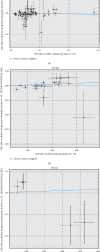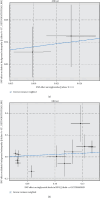Genetic Association between Lipid-Regulating Drug Targets and Diabetic Retinopathy: A Drug Target Mendelian Randomization Study
- PMID: 38757060
- PMCID: PMC11098603
- DOI: 10.1155/2024/5324127
Genetic Association between Lipid-Regulating Drug Targets and Diabetic Retinopathy: A Drug Target Mendelian Randomization Study
Abstract
Background: Diabetic retinopathy (DR) is a diabetic microvascular complication and a leading cause of vision loss. However, there is a lack of effective strategies to reduce the risk of DR currently. The present study is aimed at assessing the causal effect of lipid-regulating targets on DR risk using a two-sample Mendelian randomization (MR) study.
Method: Genetic variants within or near drug target genes, including eight lipid-regulating targets for LDL-C (HMGCR, PCSK9, and NPC1L1), HDL-C (CETP, SCARB1, and PPARG), and TG (PPARA and LPL), were selected as exposures. The exposure data were obtained from the IEU OpenGWAS project. The outcome dataset related to DR was obtained from the FinnGen research project. Inverse-variance-weighted MR (IVW-MR) was used to calculate the effect estimates by each target. Sensitivity analyses were performed to verify the robustness of the results.
Results: There was suggestive evidence that PCSK9-mediated LDL-C levels were positively associated with DR, with OR (95% CI) of 1.34 (1.02-1.77). No significant association was found between the expression of HMGCR- and NPC1L1-mediated LDL-C levels; CETP-, SCARB1-, and PPARG-mediated HDL-C levels; PPARA- and LPL-mediated TG levels; and DR risk.
Conclusions: This is the first study to reveal a genetically causal relationship between lipid-regulating drug targets and DR risk. PCSK9-mediated LDL-C levels maybe positively associated with DR risk at the genetic level. This study provides suggestive evidence that PCSK9 inhibition may reduce the risk of DR.
Copyright © 2024 Shengnan Chen et al.
Conflict of interest statement
The authors declare that there is no conflict of interest regarding the publication of this paper.
Figures




Similar articles
-
Association of genetically predicted lipid traits and lipid-modifying targets with heart failure.Eur J Prev Cardiol. 2023 Mar 1;30(4):358-366. doi: 10.1093/eurjpc/zwac290. Eur J Prev Cardiol. 2023. PMID: 36520639
-
Lipids, lipid-modifying drug target genes and migraine: a Mendelian randomization study.J Headache Pain. 2023 Aug 18;24(1):112. doi: 10.1186/s10194-023-01633-x. J Headache Pain. 2023. PMID: 37596566 Free PMC article.
-
HMGCR as a promising molecular target for therapeutic intervention in aortic aneurisms: a mendelian randomization study.Nutr Metab (Lond). 2024 Oct 14;21(1):81. doi: 10.1186/s12986-024-00849-1. Nutr Metab (Lond). 2024. PMID: 39402528 Free PMC article.
-
Can Lipid-Lowering Drugs Reduce the Risk of Cholelithiasis? A Mendelian Randomization Study.Clin Epidemiol. 2024 Feb 22;16:131-141. doi: 10.2147/CLEP.S439642. eCollection 2024. Clin Epidemiol. 2024. PMID: 38410417 Free PMC article.
-
Associations of genetically determined lipid traits and lipid-modifying agents with the risk of diabetic retinopathy: A Mendelian randomization study.Atherosclerosis. 2023 Mar;369:9-16. doi: 10.1016/j.atherosclerosis.2023.02.001. Epub 2023 Feb 11. Atherosclerosis. 2023. PMID: 36827905
Cited by
-
Diabetic Retinopathy (DR): Mechanisms, Current Therapies, and Emerging Strategies.Cells. 2025 Mar 4;14(5):376. doi: 10.3390/cells14050376. Cells. 2025. PMID: 40072104 Free PMC article. Review.
-
PCSK9 levels and diabetic retinopathy: opportunities for a potential target and novel therapeutic approach in conjunction with treating dyslipidaemia.Eye (Lond). 2025 Mar;39(4):628-630. doi: 10.1038/s41433-024-03523-1. Epub 2024 Dec 2. Eye (Lond). 2025. PMID: 39623109 Free PMC article. No abstract available.
References
-
- Cheung N., Mitchell P. Diabetic retinopathy. Lancet . 2010;376:124–136. - PubMed
LinkOut - more resources
Full Text Sources
Miscellaneous

